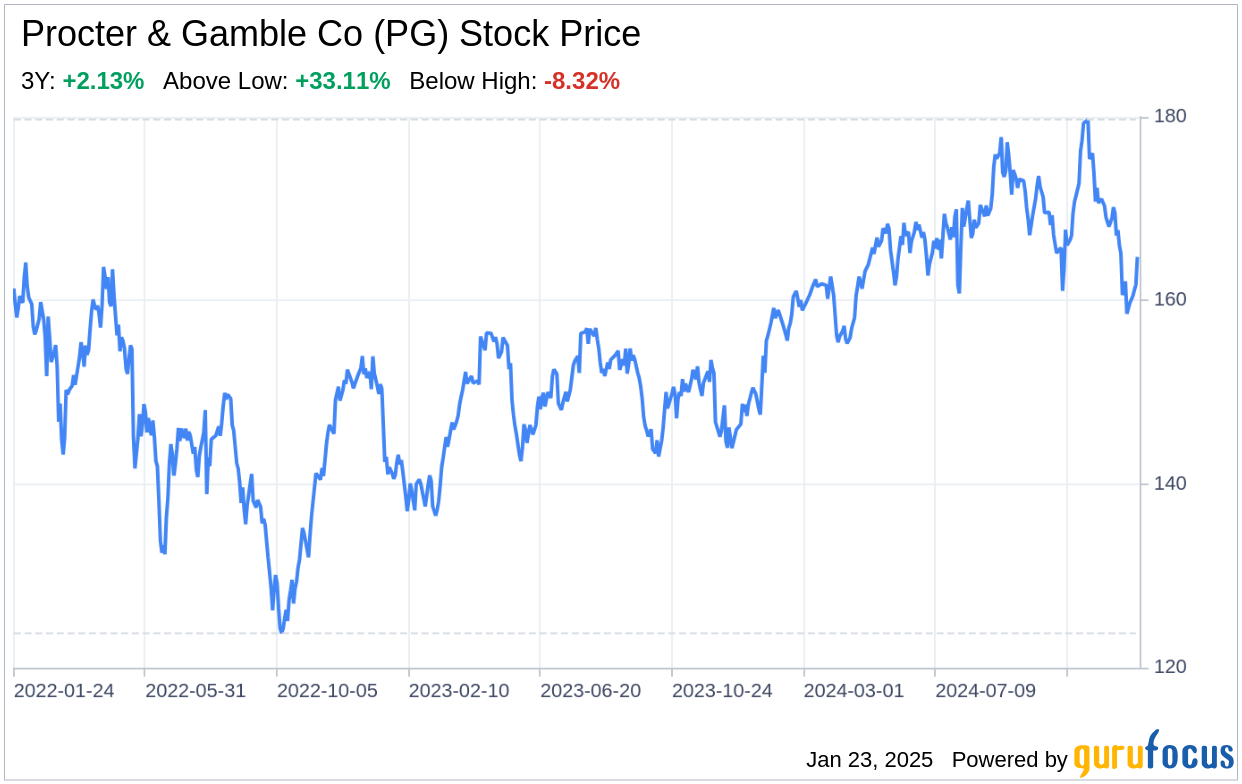Procter & Gamble Co (PG, Financial), a titan in the consumer goods industry, filed its 10-Q on January 22, 2025, revealing a financial landscape marked by resilience and strategic growth. With a history dating back to 1837, PG has cultivated a robust portfolio of over 20 brands, each generating over $1 billion in annual sales. The company's recent financial performance underscores its enduring strength, with net sales climbing to $21,882 million for the three months ended December 31, 2024, a slight increase from $21,441 million in the previous year. Operating income also saw a significant rise to $5,741 million from $4,433 million, reflecting PG's adept management and operational efficiency. Despite the challenges of cost of products sold and SG&A expenses, which have risen in tandem with sales, PG has maintained a solid financial footing, with net earnings attributable to Procter & Gamble reaching $4,630 million, up from $3,468 million. This financial overview sets the stage for a deeper dive into the company's SWOT analysis, providing investors with a comprehensive understanding of PG's strategic position.

Strengths
Brand Power: Procter & Gamble Co (PG, Financial) boasts a formidable brand portfolio that serves as the cornerstone of its market dominance. The company's brands, such as Tide, Charmin, Pantene, and Pampers, are not only household names but also leaders in their respective categories. This brand equity translates into customer loyalty and pricing power, which is evident in PG's ability to maintain and grow its sales amidst a competitive landscape. The recent financials reflect this strength, with a steady increase in net sales and operating income. The brand power is further reinforced by PG's strategic marketing initiatives and continuous product innovation, ensuring that its brands remain relevant and preferred by consumers worldwide.
Operational Excellence: PG's operational efficiency is a critical strength, as demonstrated by its ability to manage costs effectively while scaling up production to meet consumer demand. The company's gross margin, despite facing headwinds from increased commodity costs and transportation expenses, showcases its adeptness in leveraging manufacturing productivity savings. This operational prowess is reflected in the improved operating income, which has outpaced the rise in cost of products sold and SG&A expenses. PG's supply chain optimization and overhead management contribute to its ability to deliver quality products at competitive prices, further solidifying its market position.
Weaknesses
Cost Pressures: Procter & Gamble Co (PG, Financial) faces ongoing challenges with rising input costs, particularly in commodities and transportation. The recent 10-Q filing indicates a decrease in gross margin due to factors such as higher commodity costs and transportation services costs. These pressures, if not mitigated effectively, could erode PG's profitability over time. While the company has been able to offset some of these impacts through pricing actions and productivity improvements, the balance between maintaining competitive pricing and managing cost inflation remains a delicate one that requires constant vigilance.
Market Saturation: PG operates in highly competitive and mature markets where growth opportunities are often limited by market saturation. This is evident in the company's modest organic sales growth, which, while positive, reflects the challenges of expanding in an environment where many product categories have reached a high penetration level. To sustain growth, PG must continuously innovate and find new avenues for expansion, which can be resource-intensive and may not always yield the desired results.
Opportunities
Emerging Markets: Procter & Gamble Co (PG, Financial) has significant opportunities for growth in emerging markets, where rising incomes and urbanization are driving demand for consumer goods. PG's established presence and brand recognition position it well to capitalize on these trends. The company's strategic investments in regions such as Latin America, Asia Pacific, and India, Middle East, and Africa (IMEA) can lead to increased market share and revenue growth, as evidenced by the organic sales increases in these areas.
Digital and E-commerce Expansion: The shift towards digital commerce presents a substantial opportunity for PG to enhance its direct-to-consumer channels and leverage online platforms for sales growth. With consumers increasingly turning to e-commerce for convenience, PG's investment in digital marketing and online sales infrastructure can drive higher engagement and capture a larger share of the digital marketplace. This strategic focus aligns with consumer trends and has the potential to significantly boost PG's sales and market presence.
Threats
Global Economic Fluctuations: Procter & Gamble Co (PG, Financial) is susceptible to economic downturns and geopolitical tensions that can impact consumer spending and disrupt supply chains. The company's global footprint exposes it to currency fluctuations and political instability, which can affect its financial performance. The recent filing highlights the impact of foreign exchange on PG's results, underscoring the need for effective risk management strategies to mitigate these external threats.
Intense Competition: PG operates in a highly competitive industry where innovation and price competitiveness are crucial. The company faces stiff competition from both established players and private labels, which can erode market share and pressure margins. PG must continuously invest in research and development, marketing, and product differentiation to stay ahead of competitors and maintain its leadership position.
In conclusion, Procter & Gamble Co (PG, Financial) exhibits a strong competitive position, underpinned by its powerful brand portfolio and operational excellence. However, it must navigate cost pressures and market saturation while seizing opportunities in emerging markets and digital commerce. The company's ability to manage global economic fluctuations and intense competition will be critical in sustaining its growth trajectory and delivering value to shareholders.
This article, generated by GuruFocus, is designed to provide general insights and is not tailored financial advice. Our commentary is rooted in historical data and analyst projections, utilizing an impartial methodology, and is not intended to serve as specific investment guidance. It does not formulate a recommendation to purchase or divest any stock and does not consider individual investment objectives or financial circumstances. Our objective is to deliver long-term, fundamental data-driven analysis. Be aware that our analysis might not incorporate the most recent, price-sensitive company announcements or qualitative information. GuruFocus holds no position in the stocks mentioned herein.
